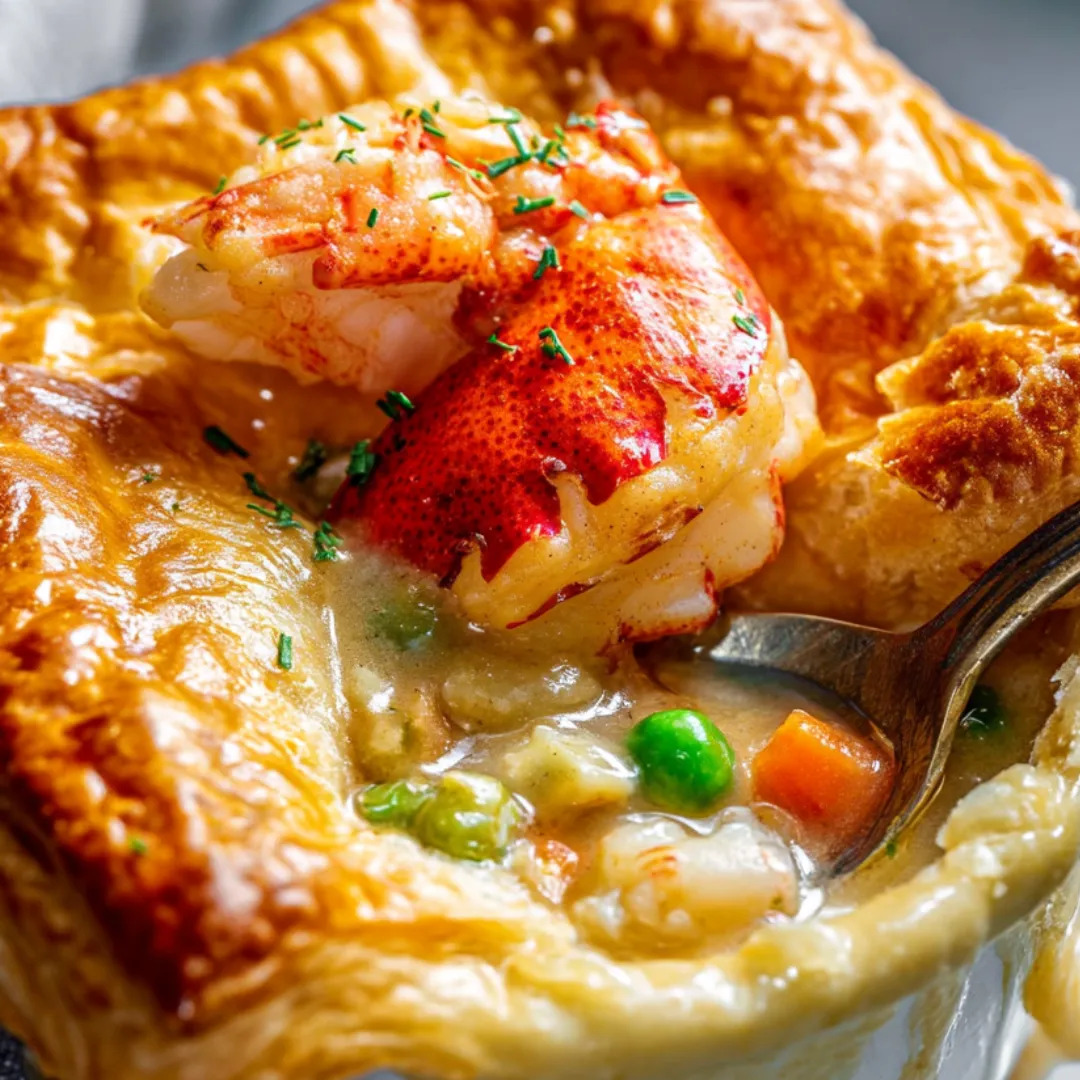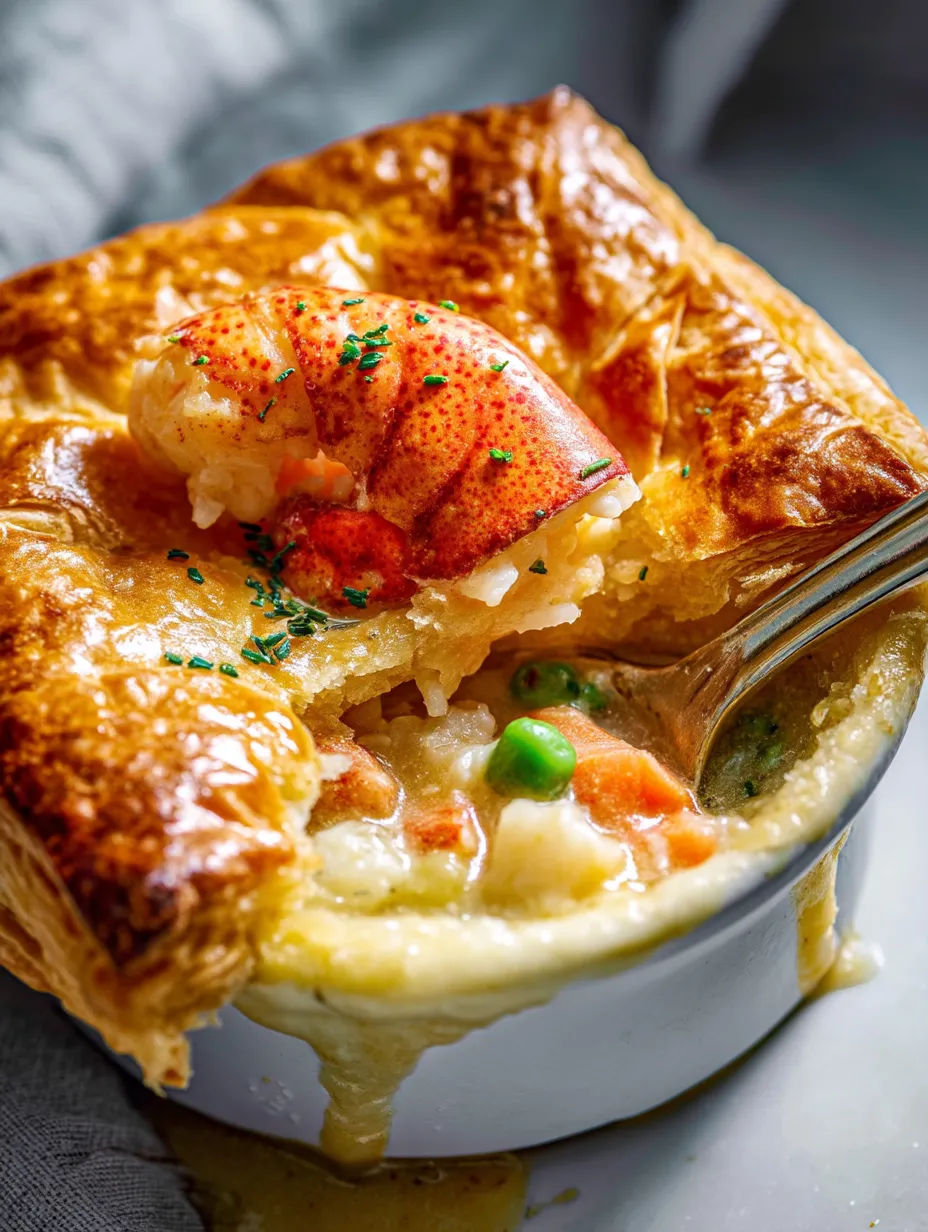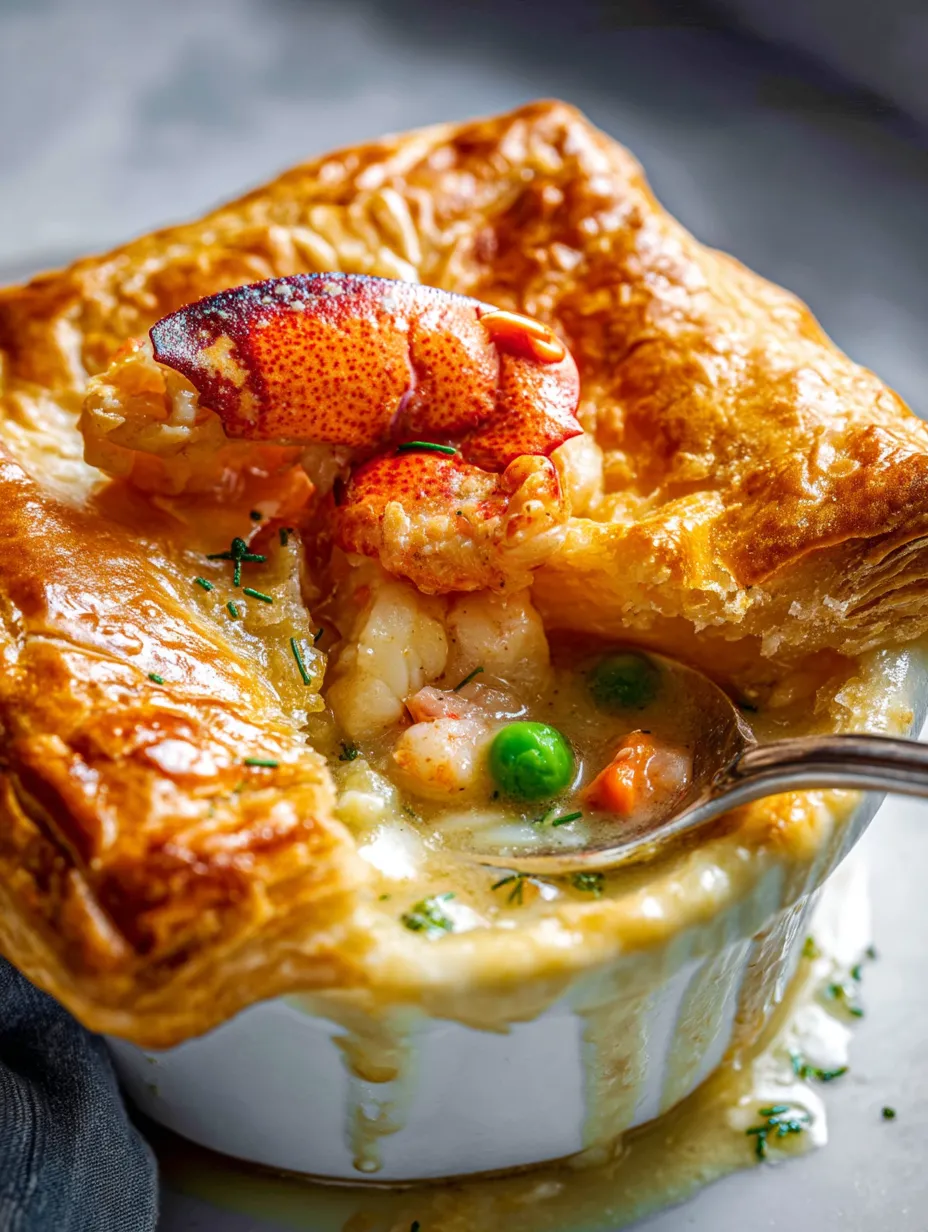 Pin it
Pin it
This lobster pot pie transforms humble ingredients into a magnificent centerpiece worthy of special occasions. The combination of sweet lobster meat with a rich, creamy sauce and flaky golden crust creates the ultimate comfort food that feels both luxurious and homey.
I developed this recipe after a memorable trip to Maine where we feasted on fresh lobster daily. When I returned home craving those flavors but wanting something more substantial than plain lobster rolls, this pot pie was born and has since become our anniversary dinner tradition.
Ingredients
- Fresh lobster meat: Provides the star flavor profile and luxurious texture that makes this dish special. Look for freshly cooked lobster at seafood counters
- Heavy cream: Creates the silky base for the sauce and adds richness that complements the delicate lobster
- Unsalted butter: Allows you to control salt levels while providing flavor foundation
- Onion, carrots, and celery: Form the traditional mirepoix that builds savory depth in the filling
- Frozen peas: Add bright color, sweet flavor, and textural contrast
- Fresh thyme and parsley: Bring herbal brightness that cuts through the richness
- All-purpose flour: Thickens the sauce to perfect consistency
- Lemon juice: Adds vital acidity that balances the creamy sauce and enhances the lobster flavor
- Puff pastry: Provides a gloriously flaky golden top that shatters beautifully when cut into
Step-by-Step Instructions
- Preheat the Oven:
- Set your oven to 400°F ensuring it reaches full temperature before baking. This high heat is crucial for creating that perfectly golden flaky crust while keeping the filling from becoming overcooked. Position the rack in the middle of the oven for even heat distribution.
- Sauté the Vegetables:
- Melt butter in a heavy-bottomed skillet over medium heat until it foams slightly but doesn't brown. Add the diced onion, carrots, and celery ensuring they're cut to uniform size for even cooking. Cook gently for 5 to 7 minutes, stirring occasionally, until vegetables soften but don't brown. They should become translucent and aromatic, releasing their flavors into the butter.
- Make the Sauce:
- Sprinkle flour over the cooked vegetables and stir constantly for a full minute to cook out the raw flour taste and create a light roux. The mixture will look paste-like and coat the vegetables. Pour in the heavy cream very gradually while whisking continuously to prevent lumps from forming. Continue stirring until the sauce thickens enough to coat the back of a spoon, about 3 to 4 minutes. The consistency should be similar to a creamy soup.
- Add the Lobster:
- Remove pan from heat before gently folding in the chopped lobster meat, peas, herbs, lemon juice, salt, and pepper. This prevents overcooking the delicate lobster which would make it tough. Fold rather than stir vigorously to keep lobster chunks intact. Let the mixture cool slightly for about 5 minutes which allows flavors to meld and prevents the pastry from becoming soggy when assembled.
- Prepare the Crust:
- On a lightly floured surface, roll puff pastry to about 1/8 inch thickness ensuring it's slightly larger than your baking dish. For individual servings, divide accordingly. Press dough gently into dish leaving slight overhang for sealing.
- Fill the Dish:
- Transfer the lobster filling carefully into your prepared dish, spreading it in an even layer but avoiding pressing it down which would remove the lightness. Leave about half an inch of space at the top to prevent overflow during baking.
- Cover with Dough:
- Drape the rolled pastry over the filling and press gently around the edges to seal. Use kitchen scissors or a sharp knife to trim excess, leaving just enough to crimp decoratively. Cut several 1-inch slits in the center to allow steam to escape during baking. Brush the entire surface with beaten egg for a glossy golden finish.
- Bake:
- Place the dish on a baking sheet to catch any potential overflow, then into the preheated oven. Bake for 25 to 30 minutes watching carefully after 20 minutes for that perfect golden brown color. The filling should be bubbling slightly at the edges or through the steam vents.
- Cool:
- Allow the pie to rest for 10 full minutes after removing from oven. This crucial step lets the filling set slightly and prevents scorching mouths. The filling remains hot while the crust maintains its crispness.
- Serve:
- Use a sharp knife to cut portions, being careful not to crush the delicate crust. Serve on warmed plates to maintain temperature longer complemented by a simple green salad with vinaigrette.
 Pin it
Pin it
My grandmother first taught me to make pot pies with chicken but lobster became my signature version after moving to the coast. She always emphasized that the gentle handling of the lobster makes all the difference in the final texture. Whenever I make this dish I think of her kitchen and how she would beam with pride at this elevated version of her classic.
Make Ahead Options
This pot pie is ideal for preparation in stages. The filling can be made up to 24 hours in advance and refrigerated in an airtight container. When ready to bake simply bring the filling to room temperature for about 30 minutes before assembling with the pastry. Alternatively you can assemble the entire pie cover loosely with plastic wrap and refrigerate for up to 4 hours before baking. Add about 5 to 7 minutes to the baking time if starting with a chilled pie.
Scaling The Recipe
For intimate dinners consider making individual pot pies using ramekins or small ovenproof dishes. This creates an elegant presentation where each guest receives their own golden domed creation. The baking time will decrease to about 20 minutes for individual portions. For larger gatherings double the recipe and use a 9x13 baking dish adjusting the baking time to 35 to 40 minutes or until the center is hot and bubbling.
 Pin it
Pin it
Perfect Wine Pairings
The rich creamy nature of this lobster pot pie calls for a wine with good acidity to cut through the richness. A lightly oaked Chardonnay provides the perfect balance with its buttery notes complementing the sauce while maintaining enough brightness. For those who prefer red wine a light Pinot Noir works surprisingly well with its earthy undertones enhancing the herbs in the dish without overwhelming the delicate lobster flavor.
The History Behind Lobster Pot Pie
Lobster pot pie represents the fascinating evolution of lobster in American cuisine. Once considered so common it was fed to prisoners and used as fertilizer lobster transformed into a luxury ingredient by the early 20th century. This dish beautifully marries the traditional English pot pie format brought by early settlers with the abundant lobster of New England waters. The addition of cream and herbs shows French culinary influence that permeated American fine dining in the mid1900s creating this perfect fusion dish that celebrates our diverse culinary heritage.
Frequently Asked Questions
- → What type of lobster meat works best for this dish?
Freshly cooked lobster meat is ideal, but you can also use frozen lobster meat if fresh is unavailable. Just make sure to thaw it thoroughly before using.
- → Can I substitute the puff pastry with another type of crust?
Yes, you can use pie dough or even phyllo dough for a different texture. Adjust cooking time as needed to achieve a golden crust.
- → Is it possible to prepare the filling ahead of time?
Absolutely! You can make the filling up to a day in advance. Store it in the fridge and assemble the pie just before baking.
- → What vegetables can I add besides peas, carrots, and celery?
Feel free to include other vegetables like diced potatoes, mushrooms, or green beans to enhance the dish.
- → How can I prevent the puff pastry from becoming soggy?
Ensure the filling is cooled before adding it to the crust to reduce steam, and avoid overfilling the pie. Pre-baking the bottom crust can also help.
